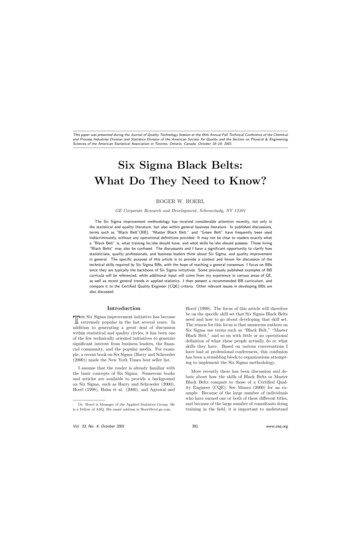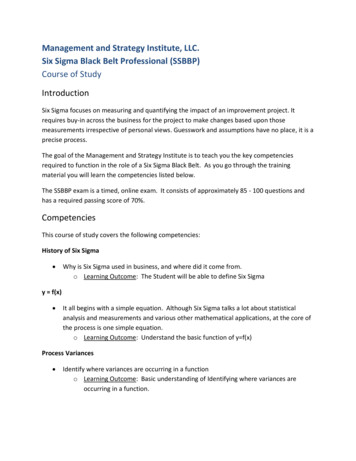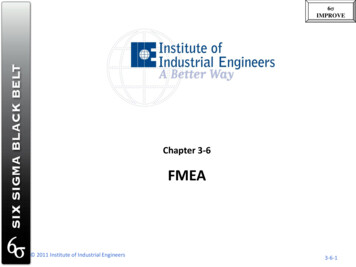
Transcription
mss # ms098.tex; AP art. # 12; 33(4)This paper was presented during the Journal of Quality Technology Session at the 45th Annual Fall Technical Conference of the Chemicaland Process Industries Division and Statistics Division of the American Society for Quality and the Section on Physical & EngineeringSciences of the American Statistical Association in Toronto, Ontario, Canada, October 18–19, 2001.Six Sigma Black Belts:What Do They Need to Know?ROGER W. HOERLGE Corporate Research and Development, Schenectady, NY 12301The Six Sigma improvement methodology has received considerable attention recently, not only inthe statistical and quality literature, but also within general business literature. In published discussions,terms such as “Black Belt”(BB), “Master Black Belt,” and “Green Belt” have frequently been usedindiscriminately, without any operational definitions provided. It may not be clear to readers exactly whata “Black Belt” is, what training he/she should have, and what skills he/she should possess. Those hiring“Black Belts” may also be confused. The discussants and I have a significant opportunity to clarify howstatisticians, quality professionals, and business leaders think about Six Sigma, and quality improvementin general. The specific purpose of this article is to provide a context and forum for discussion of thetechnical skills required by Six Sigma BBs, with the hope of reaching a general consensus. I focus on BBssince they are typically the backbone of Six Sigma initiatives. Some previously published examples of BBcurricula will be referenced, while additional input will come from my experience in various areas of GE,as well as recent general trends in applied statistics. I then present a recommended BB curriculum, andcompare it to the Certified Quality Engineer (CQE) criteria. Other relevant issues in developing BBs arealso discussed.IntroductionSix Sigma improvement initiative has becomeTextremely popular in the last several years. Inaddition to generating a great deal of discussionHEwithin statistical and quality circles, it has been oneof the few technically oriented initiatives to generatesignificant interest from business leaders, the financial community, and the popular media. For example, a recent book on Six Sigma (Harry and Schroeder(2000)) made the New York Times best seller list.I assume that the reader is already familiar withthe basic concepts of Six Sigma. Numerous booksand articles are available to provide a backgroundon Six Sigma, such as Harry and Schroeder (2000),Hoerl (1998), Hahn et al. (2000), and Agrawal andDr. Hoerl is Manager of the Applied Statistics Group. Heis a Fellow of ASQ. His email address is Hoerl@crd.ge.com.Vol. 33, No. 4, October 2001Hoerl (1999). The focus of this article will thereforebe on the specific skill set that Six Sigma Black Beltsneed and how to go about developing that skill set.The reason for this focus is that numerous authors onSix Sigma use terms such as “Black Belt,” “MasterBlack Belt,” and so on with little or no operationaldefinition of what these people actually do or whatskills they have. Based on various conversations Ihave had at professional conferences, this confusionhas been a stumbling block to organizations attempting to implement the Six Sigma methodology.More recently there has been discussion and debate about how the skills of Black Belts or MasterBlack Belts compare to those of a Certified Quality Engineer (CQE). See Munro (2000) for an example. Because of the large number of individualswho have earned one or both of these different titles,and because of the large number of consultants doingtraining in the field, it is important to understand391www.asq.org
mss # ms098.tex; AP art. # 12; 33(4)392ROGER W. HOERLTABLE 1. List of AcronymsANOVA – Analysis of varianceASQ – American Society for QualityBB – Black BeltCEO – Chief Executive OfficerCQE – Certified Quality EngineerCTQ – Critical to quality metricsDFSS – Design for Six Sigma (Six Sigma applied to design)DMAIC – the Define, Measure, Analyze, Improve, Control sequenceDOE – Design of experimentsFMEA – Failure modes and effects analysisGB – Green BeltGE – General Electric CorporationID – Interrelationship digraph (knowledge based tool)MBB – Master Black BeltMS – Master of Science DegreeQFD – Quality function deploymentRSM – Response surface methodologyR&R – Repeatability and ReproducibilitySIPOC – Process map identifying suppliers, inputs, process steps, outputs, and customersSPC – Statistical process controlthe differences where they exist. Therefore, I discussthe work that a Six Sigma Black Belt (BB) actuallydoes, and then what specific skills are required to dothis work. This will be documented in the form of arecommended curriculum. I focus on BBs because Iview them to be the technical backbone of successfulSix Sigma initiatives—the folks who actually generate the savings.I begin by briefly reviewing the types of projects aBB might lead, which will help me explain their role.Once I have clarified their role and actual work, itwill be easier to discuss appropriate technical skills,and therefore training, required to do this work. Ithen compare BB curricula with the CQE requirements as well as a typical MS in applied statisticscurriculum. Lastly, I discuss other BB developmentissues that are relevant, such as selection of candidates, mentoring after the training, and impact oncareer paths.Because of the large number of acronyms, I list allacronyms used in this paper in Table 1.What is the Role of a BB?In this section, I begin by describing some examples of projects that Black Belts have been leading inGE before discussing the BB role itself. The examples discussed here come from a variety of differentJournal of Quality Technologybusiness contexts, but they all demonstrate how analytical Six Sigma methods have been used to helpunderstand and address business issues. It should benoted that none of these are traditional manufacturing examples because of the types of organizationswith which I have been primarily working—financeand other general business operations. Obviously,BBs perform corresponding improvement activitiesin manufacturing and engineering. Due to confidentiality issues, I am not at liberty to reveal details ofthe actual tools applied, or specific financial resultsobtained. Rather than trying to “sell” Six Sigma tothe reader, my intent is only to give an overview ofthe types of projects for which a BB may be responsible. I trust that there is enough detail provided toaccomplish this objective.Examples of BB projectsWebsite Download TimeIn this example, a business was providing information to customers over a website. This website hadmany customers, but was attempting to gain greatermarket share from its competitors. Market researchhad indicated that a primary concern for customerswas the length of time that individual website pagestake to download.To understand how to improve download time forVol. 33, No. 4, October 2001
mss # ms098.tex; AP art. # 12; 33(4)SIX SIGMA BLACK BELTS: WHAT DO THEY NEED TO KNOW?this website, a designed experiment (DOE) was constructed. The goal of this DOE was to model howboth the average and the variation of download timewere affected by various factors including architecture of the page and various technological optionsavailable. The DOE was conducted to simulate bothpersonal (home) and commercial (office) users of thewebsite in order to best capture the full range of potential customer experiences.The result of the DOE was the identification ofthose factors that have the most impact on the download speed of the website. The business used the results of the DOE to prioritize the order in which theyworked on the improvements. At the time of thiswriting, most of the changes have been implemented,and the results have been found to closely follow thepredictions from the model based on the DOE. Control mechanisms have also been put in place to allowsenior management to track the download speed (andother key variables) over time. The financial benefitshave been substantial.Customer RetentionAnother example of a Black Belt project involvesunderstanding customer profiles at a health care insurance business. The business sold insurance to individuals nationally. At the initiation of this project,the business had seen the number of policy lapsesincrease. In other words, more people were not renewing their policies. The business wanted to understand the financial impact that this might have, andwhat might be done to reverse the trend.The approach that the Black Belt used here wasto determine which factors in a customer profile arepredictors of policy lapses for the business. She wasable to show that certain factors in a customer profile were strongly correlated to higher lapses. Shethen investigated the population of customers thatwere lapsing in their insurance policies, according tothose factors. She was thus able to estimate the financial impact that the business would see as a resultof these lapsed policies. The ultimate objective, ofcourse, was to prevent lapses of profitable policiesand encourage lapses of unprofitable ones. The financial benefits are just beginning to be recognized.Equipment DeliveryOne of the GE businesses promises to deliverequipment to their customers anywhere in the US,within a matter of days. They consider this to be oneof their competitive advantages, in that their fulfill-Vol. 33, No. 4, October 2001393ment process is superior to that of their competitors.They were interested in determining the factors thatwere driving the variation in equipment delivery cycle time.The business had an enormous amount of dataassociated with their equipment delivery process, although when they evaluated the data quality viaa “gauge R&R” (generic Six Sigma term for measurement system evaluation), they found some issues requiring improvement of their data collectionand management process. They were able to collect “good” data on a large number of factors thatwere potentially influencing the fulfillment processincluding the type of equipment that was being delivered, the plant that was manufacturing the equipment, the geographic location of the customer, andvarious other factors. The business was able to determine which of these factors was having the largesteffect on the variation associated with equipment delivery cycle time and focus improvement efforts onthose. Improvement efforts to reduce the deliverycycle time variation are ongoing. In this case, therewill be some cost savings due to reduced rework inthe delivery process, but the primary benefit will betop line growth from improved customer satisfaction.The BBs Fit Within the OrganizationWhile the focus of this article is on skills requiredby BBs, it is important to understand how BBsfit into the bigger picture in order to understandtheir role. The overall effort within an organization is typically led by a Quality Leader, or perhaps“Champion.” The Quality Leader’s work is primarily strategic—developing an implementation strategy, setting objectives, allocating resources, monitoring progress, and so forth. The Master Black Belts(MBBs) have a more “managerial” role, in that theyoften are responsible for all Six Sigma work done ina particular area or function. Typical duties includeselection, training, and mentoring of BBs, project selection or approval, and review of projects completed.MBBs are expected to have a deeper technical knowledge of the tools as well as other “soft” skills.The BB is in a more operational role, that ofrolling up the sleeves and making improvements happen. Within GE, the MBBs and BBs have been fulltime resources, freed up from their “regular jobs” tofocus on Six Sigma. (In GE, people who are trainedand doing Six Sigma projects as part of their “regularjob” are referred to as Green Belts (GBs).) In GE,BBs have also generally reported to the Six Sigmawww.asq.org
mss # ms098.tex; AP art. # 12; 33(4)394ROGER W. HOERLQuality Leader, rather than to the leader of the business function in which they are working. An important point, which I return to later, is that the BB roleis intended to be a temporary assignment—typicallytwo years. The BB role is viewed as an important developmental experience, which the BBs will benefitfrom during the remainder of their careers. This hashuge implications for BB selection that is discussedbelow.In most cases, a BB is a leader of a team thatis working on a problem. Therefore, while possessing the ability to apply statistical tools to solve realproblems is paramount to performing the role, otherskills are needed as well. These include organizational effectiveness skills, such as team and projectleadership, as well as skills in meeting management.One reason these “management” skills are importantis that the typical BB leads several projects at thesame time, i.e., they are “multi-tasking.” I agreewith a reviewer who points out that in today’s business environment, everyone is basically multi-taskingand managing several projects, each of which needsto produce hard financial results.Other “soft skills” required for the BB to be effective include the ability to clearly present the resultsof projects, both orally and in writing. In addition,training skills are very helpful since the BB may haveto do some degree of training if team members havenot yet been Six Sigma trained. (Hopefully, the entire team is Green Belt trained, but even so this isnot as in-depth as the BB training.) The mentoringwhich the BB receives from the MBB may involveinstruction in some of these skills in addition to technical mentoring. In summary, BBs must be resultsoriented leaders who also possess the right technicalskills. Their training should focus on the skills theyneed to perform this role effectively. Conversely, itshould not be based on “typical” statistics curriculain academia or business.After completing a certain number of financiallysuccessful projects, BBs are “certified.” The exactnumber of projects varies by busi
the work that a Six Sigma Black Belt (BB) actually does, and then what specific skills are required to do this work. This will be documented in the form of a recommended curriculum. I focus on BBs because I view them to be the technical backbone of successful Six Sigma initiatives—the folks who actually gener- ate the savings. Ibegin by briefly reviewing the types of projects a BB might .










